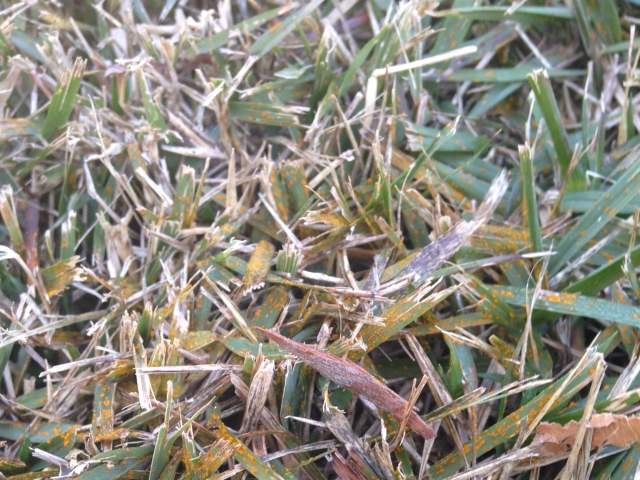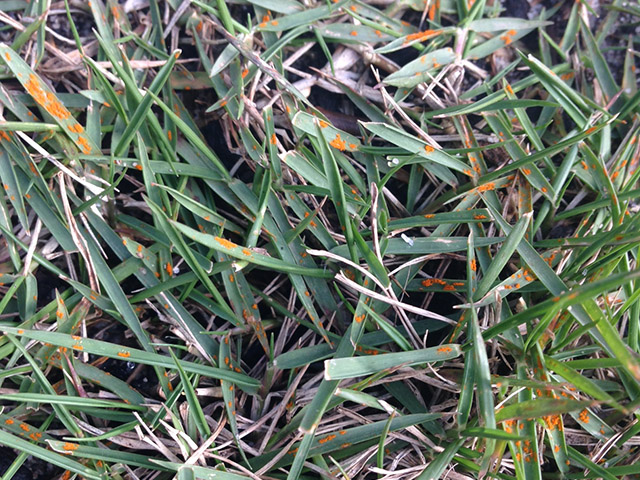Rust Disease Activity in NSW and QLD
Rust has been detected on warm season grasses in both NSW and QLD in recent weeks. Rust is generally a disease of high cut turf situations. Read on to learn more.
What is Rust?
Rust is generally a disease of high cut turf situations, with outbreaks most common in over sown racetracks, sports fields, parks and turf farms. Occasionally, symptoms may also occur in golf course fairways and roughs.

Rust activity on warm season grass in New South Wales.
There is a variety of rust diseases that infect turf, including Leaf Rust, Crown Rust and Stem Rust. The causal organisms that are responsible for Rust diseases in turf, all belong to the same genus – Puccinia species.The disease commonly attacks Perennial Ryegrass and Kentucky Bluegrass Turf varieties; however other grass species may become affected from time to time, eg. Tall Fescue, Buffalo and Zoysia turfgrasses.
From a distance, rust-infected turf appears to have a dull yellow-green appearance. Close inspection of the rusted leaves reveals numerous small yellow/orange lesions on the leaf blades that enlarge over time. The spores rub off easily like powder, and walking through a turf sward with significant amounts of infection will disturb and release the spores and become quickly evident upon shoes. Rust spores are spread by wind or via maintenance equipment to other areas of unaffected turf during the growing season. Through multiple rust infections, severely infected turf stands become noticeably thin and if not treated can eventually die.
Rust outbreaks are most common in late summer and early autumn, although the disease can be active in the spring. Rust disease is more severe in turf that is deficient in nitrogen. Rust is a disease of slower growing turf, so other factors that contribute to poor turf growth tend to favour rust infection. Such factors may include summer heat and drought stress, compaction, and shade.
Stem rust outbreaks require cool wet conditions with temperatures of 10°-20°C, while Crown Rust prefers higher temperatures (20°-30°C). Prolonged periods of leaf wetness (more than 10 hours) is important in the development of all rust diseases. eg.long evening dew periods. The pathogen survives as resilient spores over the winter, or as inactive Mycelium.

How do we mitigate incidence of Rust?
To reduce the incidence of Rust disease, maintain turfgrass vigour by applying adequate but not excessive nitrogen fertilisation and irrigate in the morning according to the evapotranspiration needs of the turfgrass. Provide good air movement on the turf surface. Mow the turfgrass regularly and make sure that clippings are removed if infection is apparent, to reduce the number of spores.
When disease outbreak becomes severe or sustained, fungicidal control is required. Interface® Fungicide from Envu, is the only fungicide currently registered to control rust disease in turf in Australia. The combination of the Interface active ingredients, iprodione and trifloxystrobin work in tandem to provide quick knockdown and excellent residual performance (up to 28 days) on Rust diseases. In addition to this, the Stressgard® components in Interface increase turf health and reduce stress and therefore help to enhance metabolic processes within the plant to stimulate plant growth and reduce the potential for further infection from rust disease.
The rate of Interface Fungicide for rust is 12.5L/ha or 125mL/100m2. For leaf and stem rust, apply Interface as a foliar application in a minimum of 400L/ha and allow the product to dry on the leaf. For Crown Rust it is best to apply in a higher water volume (minimum of 800L/ha) to ensure that the product reaches its target.
For more information on Interface, get in touch with our team.
Always read the label before use.
Back to Other Diseases